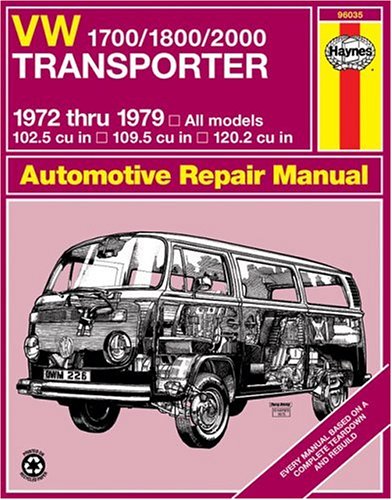VW Bus Book Reviews
Like you’ve seen, we are restoring a 1978 VW Type 2 Transporter, a.k.a. The Bus. We’ve acquired a few books over the last couple of months about buses, and some are certainly better than others. So here’s what I think about them.
The Muir Book
“How To Keep Your Volkswagen Alive”, John Muir [amazon].
This is the classic, quintessential, indispensible guide. Well written and produced, it covers everything about owning, maintaining and repairing your air cooled VW (Bus, beetle/bug, whatever). If you have an older VW and you don’t have this book, go out now and get it. If you only buy one book, buy this one. Highly recommended.
The Bentley Manual
_“Volkswagen Official Service Manual”, Bentley Publishers [amazon]. _
This is a workshop manual, written in dry, terse, crystal clear language, with excellent photos, wiring diagrams and diagnostics procedures. I would also recommend Bentley.
Rebuild Your Engine
“How To Rebuild Your Volkswagen Air-Cooled Engine”, Tom Wilson [amazon].
At time of writing I’ve only just started tearing the engine down, but I have had this book out on my workbench along with the previous two, and it has helped me out so far.
Haynes
“VW Transporter 1700/1800/2000”, Haynes [amazon].
I don’t really recommend this book. There’s nothing particularly wrong with it, but with Muir and the Bentley on your bench, you just don’t need it.
Traveling with the VW Bus and Camper
“Traveling With The VW Bus And Camper”, David and Cee Eccles [amazon].
We picked a copy of this up in Seattle, and it’s great. It is a coffee-table book, not a workshop manual, with hundreds and hundreds of photos of buses and adventues in buses from around the world. Loads of ideas of how to restore your bus, and inspiration galore for getting the bus running and going on adventures of our own. I like it.
Still Cleaning Up the Shopsmith
So a couple of fairly brief cleaning sessions have got me to the point this evening of beginning to tear down the motor, the final large piece remaining. The way tubes (I know the real names for them now, thanks Dave) are clean, the headstock and carriage are clean and mounted on the ways. Tony found the original manual (copyright date 1951) and the jointer-shaper fence, and I’m feeling like a few more hours’ work and I’ll have the beast running again.
Lathe Restoration
My latest project is to restore Ky’s grandfather’s shopsmith tool:
It’s a really cool old-school piece of machinery with a 1/2hp motor, reconfigurable into a lathe, a table saw, a drill press, and probably any number of other cunning layouts. We picked it up last weekend from the storage shed, and brought it back home. It probably weighs 200-300 lbs, and isn’t quite in usable condition. The slider rails for the motor head are slightly corroded and the motor and lathe rests don’t slide along the bar. The motor needs rewiring, and probably also being grounded. The whole tool generally needs cleaning up and a little tlc to get it back into working action.
This evening I made a start, and disassembled the major components and cleaned up the main rails. WD-40, steel wool and elbow grease has made the rails significantly shinier again, but I may try to polish them up a bit more with some emery paper or even something like Brasso. I made a start at cleaning up the main frame pieces, but need to finish those off. I was also thinking about replacing the top sheet of the cabinet with a thin sheet of stainless, or something else more resistant than thin plywood.
The photos of this evening’s work are here.
Update (April 3rd): I polished the rails a little, and determined it didn’t really do anything too useful. I also cleaned up the rest piece, and slid it back onto the rails. Having manhandled it off, it slid back on nice and smoothly now it’s all cleaned up. Photos.
Agile Fallacies
Based on reading and hearing people’s (mis)interpretations of Agile software development, here are some Agile fallacies I have seen, both from detractors and supporters of Agile:
Agile means chaos. On the contrary, being Agile requires a development team to be highly organized and disciplined in how they go about their work, and it results in a highly predictable development process which will automatically drive towards maximizing value to the customer. When someone writes chaos I assume what is being misunderstood are the requirement of an Agile team to be self-managing, and the much diminished amount of documentation required up-front.
There’s no design. There is as much design as a correctly implemented Waterfall process, except Agile design work is spread throughout the duration of the project and is performed on a “just-in-time” basis, thereby leveraging the advantage of having as much knowledge as possible at the time any piece is designed.
Agile is easy. Agile development processes tend to be lightweight and simple, but that doesn’t make them easy. It requires diligence and effort in order to be “agile”, and to correctly follow a methodology such as Scrum.




